Christmas cactus, Schlumbergera spp., is an umbrella term for several species and cultivated varieties of South American epiphytes that cling to trees and rocks for support in the wild, drawing sustenance from rainwater and bits of organic matter in their immediate environment.
It is a popular indoor houseplant because of the profusion of blooms that appear between Thanksgiving and Christmas, depending upon the variety.
Sometimes plants develop hair-like growths between their stem segments, or cladodes. These are called aerial roots.
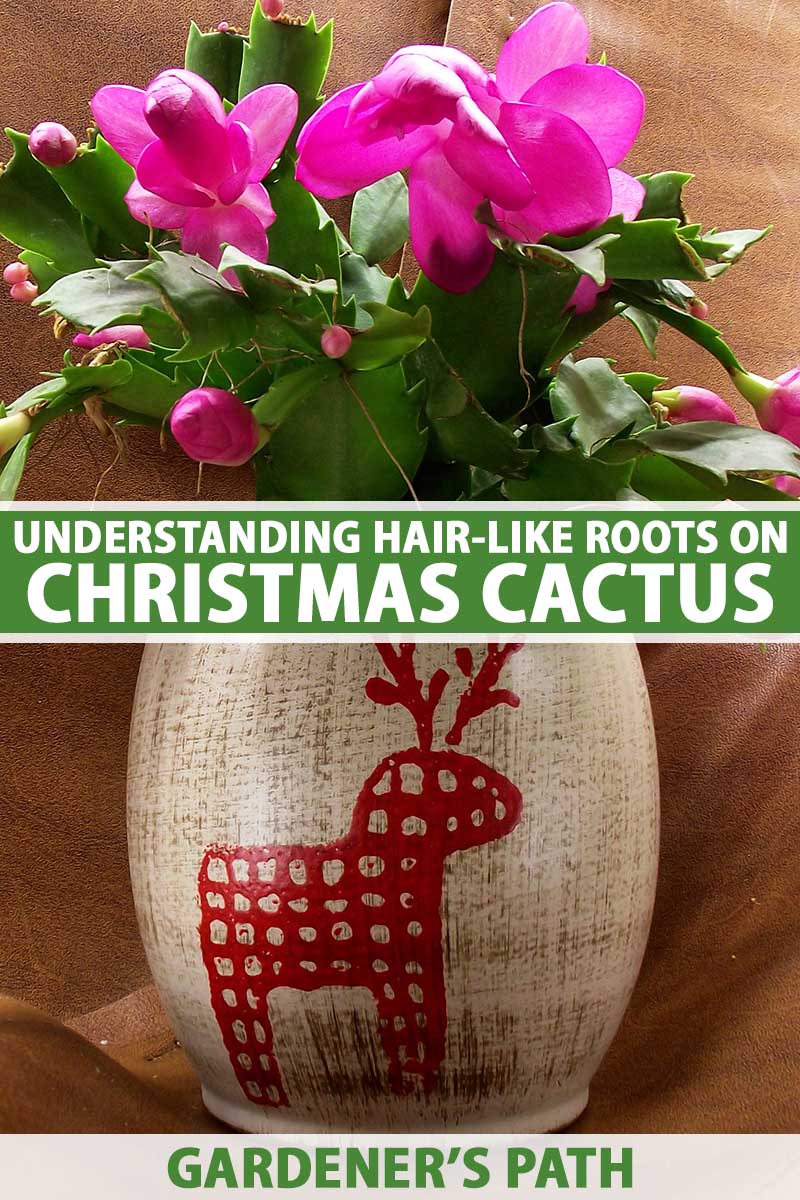
We link to vendors to help you find relevant products. If you buy from one of our links, we may earn a commission.
In our guide to growing Christmas cactus, we discuss all you need to know to cultivate this tropical epiphyte indoors.
In this article, we talk about aerial roots on Christmas cacti, and what they may mean to the home gardener.
Here’s the lineup:
What You’ll Learn
A plant’s behavior can teach us a lot about its needs, so let’s dig in and get to the bottom of this!
Understanding Aerial Roots
Aerial roots grow above ground from stem or leaf tissue. Their development may be a typical characteristic of a species that is always present, or an adventitious, random occurrence that coincides with a plant’s need to adapt to some change in its environment.
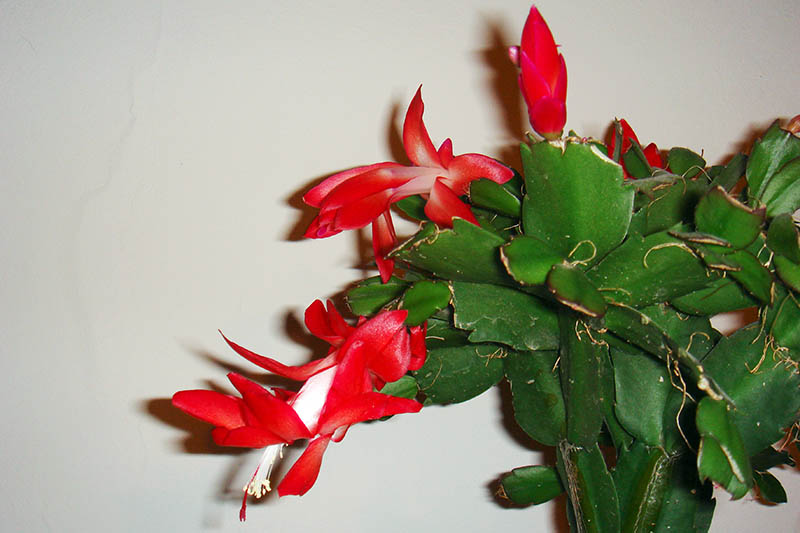
Four primary functions of aerial roots are: support, moisture absorption, nutrient uptake, and oxygen intake.
In the case of tropical Schlumbergera that in their natural habitat cling to trees and rocks in the sun-dappled shade of a rainforest canopy, these hair-like, brownish growths appear when fundamental needs are unmet.
Let’s find out what they are.
Adapting to Survive
A Christmas cactus is wired to grow in a tropical climate where it can partake of the available air, light, nutrients, and water.
When it doesn’t receive enough of these essentials, the plant reacts and responds. One way it tries to fulfill its needs is by generating aerial roots from its foliar tissue.
In nature, a lack of sunlight may cause bending or stretching in an attempt to locate more and remedy the deficiency. To keep a secure footing, it may grow adventitiously for added support while doing so.
In addition, if the sub-surface roots that absorb moisture, nutrients, and oxygen become oversaturated, they are unable to function. Generating a backup system becomes necessary, to absorb what it can from the air for sustenance.
The same needs apply to those grown as houseplants. A little detective work will usually reveal the reasons why these fragile growths have made an appearance.
Evaluating Causative Factors
While it’s not uncommon for a Christmas cactus to grow aerial roots, this is not just another natural trait, but rather, a response to some kind of environmental stress.
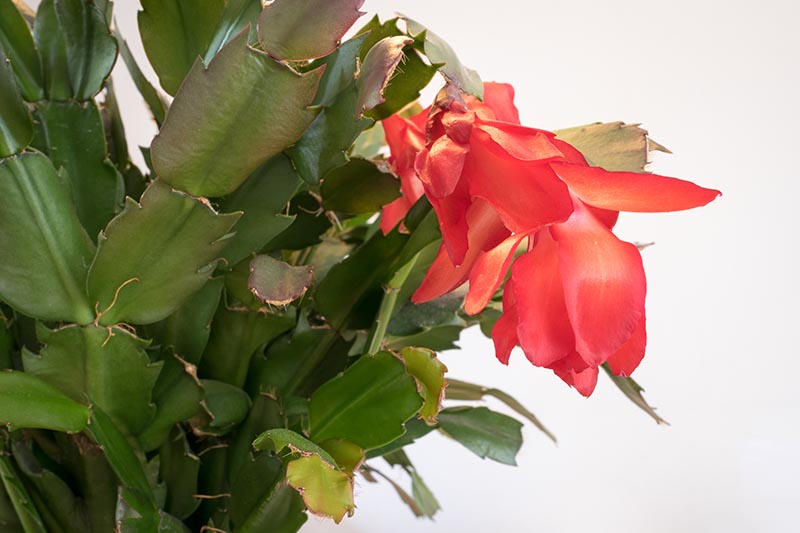
Six common stressors that may induce adventitious growth are: unsuitable light, inappropriate temperature, oversaturation, lack of water, lack of nutrients, and traumatic events.
Let’s explore each of these potential stressors:
1. Unsuitable Light
Schlumbergera species are phototropic, meaning they are highly responsive to light changes.
To get a Christmas cactus to bloom, it is necessary to induce dormancy by manipulating the light and temperature to mimic winter conditions.
During the growing season, consistent indirect sunlight is needed. Too little may result in improper chlorophyll-to-energy conversion, and too much may scorch buds, leaves, and blossoms.
A consistent supply of appropriate light is crucial to prevent undue stress to the plant, which may result in the formation of aerial roots as they attempt to reach for brighter conditions.
2. Inappropriate Temperature
The ideal temperature for indoor cultivation is between 70 and 80°F. Temperatures that are too cold or too hot, or those that fluctuate widely, may have an adverse effect.
Simulated indoor dormancy for the purpose of bud formation requires temperatures in the 50 to 55°F range.
Consistency of temperature during both the growing season and the period of dormancy helps to minimize stress, whereas fluctuating temps may result in hairlike growths.
3. Too Much or Too Little Water
In addition to causing the potting medium to be soggy or oversaturated, an overabundance of moisture may cause yellowing leaves, rotting plant tissue, and an inability to take up nutrients and water via roots below ground.
To avoid potentially lethal complications of wet feet, as well as the production of the hairlike structures in question in response to stress and an inability to acquire adequate nutrients via the soil, be sure the pot your Christmas cactus is growing in has an adequately sized hole in the bottom, to allow excess water to flow through.
Also make sure the potting mix is loose and well-draining.
Don’t water until the top one to two inches of potting medium feels dry. And water only at the soil level, not on the leaves.
You may be able to help a plant recover by unearthing it, rinsing the sub-surface roots clean, trimming off any rotten plant material, and repotting it in new, lightly moist potting medium. This will cause additional stress to your plant in the short run, but repotting may ultimately save it.
You can read more about selecting the best potting mix for Christmas cacti here.
Alternatively, you can take cuttings to propagate for a completely fresh start.
Underwatering can be equally detrimental. Leaves that lose their plumpness and begin to curl are signs of too little moisture. And growths may appear, in an effort to glean moisture from the air.
If they haven’t completely dried up, they may be able to bounce back with a thorough soaking and draining, followed by a vigilant regimen of watering when the top one to two inches of potting medium are dry.
Keep in mind that though they are succulents, they still require irrigation from time to time, typically more when they are blooming and less when they are dormant.
4. Lack of Nutrients
Nutrient deficiency can cause adventitious growth for the purpose of seeking out new sources of food, when sub-surface roots fail to take up the required nourishment.
If your cactus is large and old, your potting medium may be depleted of nutrients. Repot in a fresh medium that offers good drainage, and fertilize with a cactus and succulent product.
Both old and young plants benefit from the addition of fertilizer during the growing season. Follow package instructions for best results and.
Learn more about feeding Christmas cacti here.
5. Traumatic Events
Finally, flora can suffer a degree of shock when it experiences traumas such as having cuttings taken for propagation, or suffering accidental damage.
Aerial roots may appear in response to the upset. Returning your plant to reliably constant conditions can help it to readjust to its surroundings.
Listen When Your Plant Talks
When a plant literally reaches out seeking help, with specialized growth that increases its ability to stabilize its position, and increase its intake of essential nourishment, it’s time to evaluate its home environment and recent events.
With a few adjustments, adventitious roots will wither and drop off, and you are likely to see few to none thereafter. This is encouraging evidence of optimal functioning.
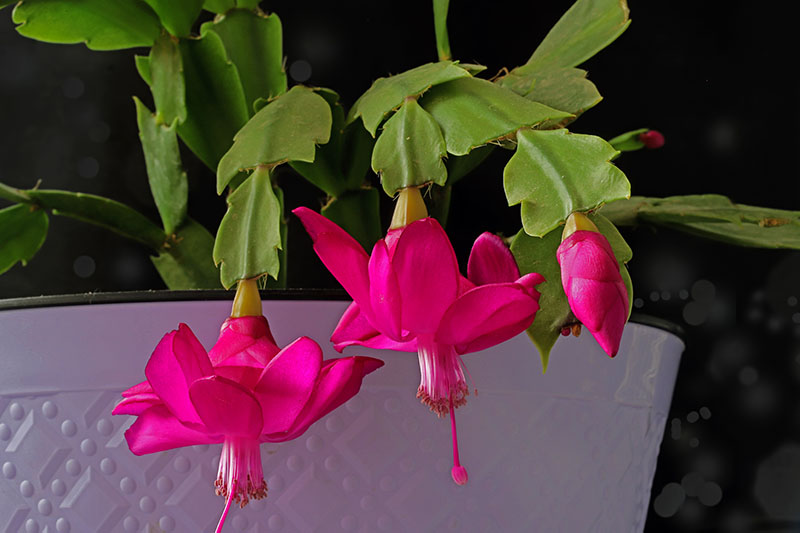
Some folks find the hair-like growths unsightly and snip them off, but I prefer to keep them as reminders of rainforest days and wild Schlumbergera that fend for themselves.
Have you seen these on your own plants? What did you do to adjust your cacti’s care regimen? Please send us a message in the comments below!
If you’re a fan of the Christmas cactus and found this article informative, you’ll enjoy reading these guides next:
- How to Identify and Control 7 Common Christmas Cactus Pests
- Is Christmas Cactus Toxic to Cats?
- Why Is My Christmas Cactus Turning Purple?
- How to Prevent Christmas Cactus Bud Drop
© Ask the Experts, LLC. ALL RIGHTS RESERVED. See our TOS for more details. Uncredited photos: Shutterstock.
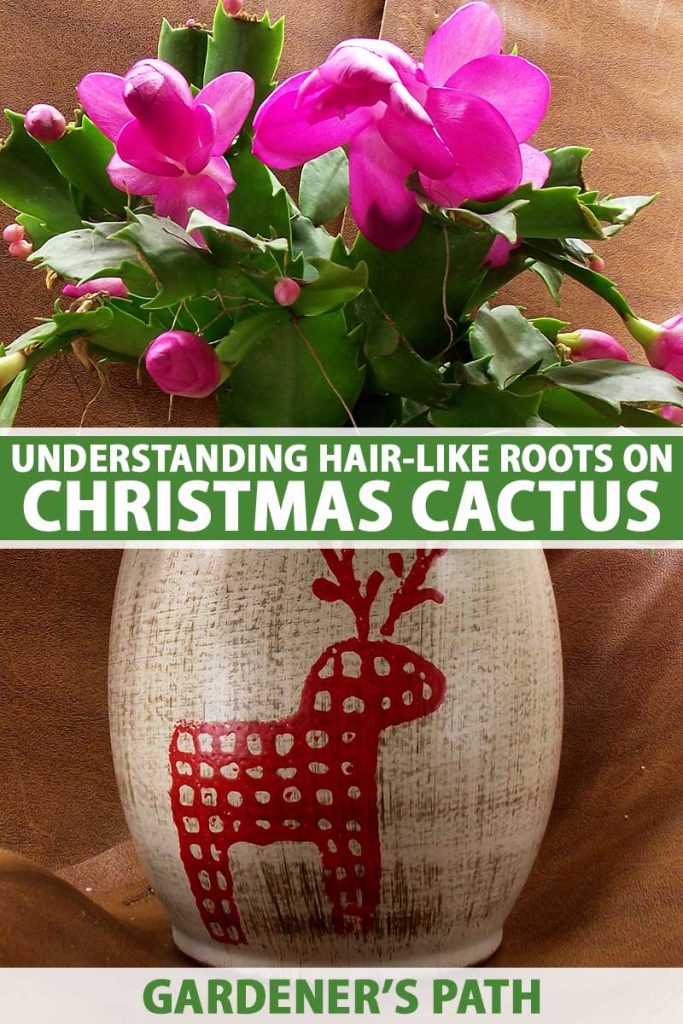
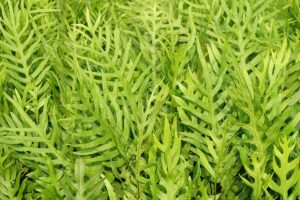
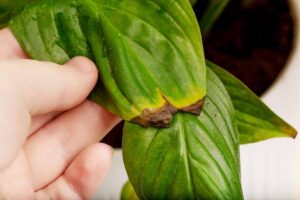
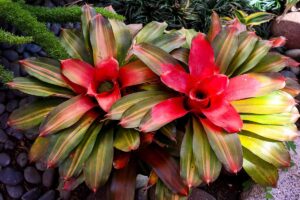
This is my first Christmas cactus. I have it in the east window in direct sun. The soil had dried out and I’m keeping it moist. I’ve had blooms but not covering the entire plant. The air roots are all over the plant. I tried rooting a few leaves. Currently several buds. So I need to read this again to grow it right.
Plastic bag over it to keep moist?
Thanks, Nancy
Hi NancyJ –
The adventitious roots are likely due to a lack of water and too much sunlight.
Christmas cactus, not being a desert cactus, requires moisture when the top two inches of potting medium are dry, and a location with indirect sunlight.
It’s excellent that you have adjusted the water, so now all you need to do is take your plant out of direct sunlight and place it where the light is bright, but indirect.
This was very informational and let me know exactly what was going on with my xmas cati and now I know to listen to my plants cause they are talking to me and letting me know that something is wrong and I need to address it. Thank you so much for your article it helped me not to lose my plant.
Hi Twyla –
We are so happy you found the article helpful!
What is the best fertiliser for them?
Hi Jan –
The Christmas cactus prefers a monthly dose of a well-balanced liquid plant food at half strength during the spring and summer. Some folks also give it a regular dose of Epsom salts on a different week during the month to satisfy its craving for magnesium. The standard ratio is 1 teaspoon of Epsom salts to 1 gallon of water.
Pierced soil with thin screwdriver added some rice water placed on windows get light waiting
A very insightful read indeed! I would imagine that many readers, like myself, live outside of the USA which is one of the few countries (if not the only one) not using the metric system. It would be very useful and would add value to your articles if you could include temperatures in Celsius as well as Fahrenheit. Otherwise a lovely article with great insights!
Hello Reinhardt –
We’re glad you found the article informative and thank you for your suggestion.
I’m wondering if you know anything about these “oddities” that are part of the leaf-chain. They are on my grandmothers very old plant, and they appear to be shaped more like a traditional cactus, round, with spikes. There are also “baby spike balls” on the upper leaves. I haven’t been able to find info on what these are, and why they appeared (many years ago). I wonder if they are vestiges from a different species? They are cool-looking and just seem odd to be placed in between the standard leaves.
Hello Professor Stone –
I’ve read about grafted Christmas cacti, but have never seen one. Grafting to dragon fruit is not uncommon and may be what you have here. Thanks so much for sharing!
I have a cactus that has never bloomed. It has the hair like roots growing from every leaf. Does anyone know what I need to do with this.
Hi Vivian – Hairlike roots can be a natural phenomenon or a sign of stress. The same reasons that may cause a proliferation of hairlike roots may contribute to a failure to bloom. They are: Unsuitable light Inappropriate temperature Too much or too little water Lack of nutrients Traumatic event In addition, a period of artificially induced dormancy is required for blooming. Please see our article, “How to Make Your Christmas Cactus Bloom” for details. To summarize the process, a period of dormancy is required, during which fertilizer is suspended, moisture is limited, light exposure is minimized, and the temperature… Read more »
I have a cutting that I’m rooting to make a plant and that is what has developed aerial roots. Which is why I think it’s happening. I certainly stressed it by taking it from its big plant.
Hi Hannah –
It could be the stress of having been cut from the parent plant, but it might also be the cutting’s attempt to absorb moisture from the air around it.
Use a moisture meter as a guide and water when the top inch of soil dries out.
My Christmas cactus has thorns and hasn’t bloomed in the 2 years I’ve had it. What do I do?
Hi Michelle –
If your Christmas cactus is growing hairlike roots, it is likely suffering from one or more of the types of stress discussed in the article.
For tips on getting a Christmas cactus to bloom, please see our article, How to Make a Christmas Cactus Bloom, for detailed information.
I had NO CLUE that there were TROPICAL cacti. I just assumed it was desert. Now I know why it’s unhappy! Thank you!
Hi Amanda –
You’re welcome! We’re glad you found the article and wish you all the best with your Christmas cactus!